Stroke Case Study: Kylie's Experience with Stroke and Care in NZ
VerifiedAdded on 2020/09/03
|14
|4810
|42
Report
AI Summary
This report presents a comprehensive case study of a 60-year-old woman named Kylie who experienced a stroke, focusing on various aspects of her condition and care. The report begins with an introduction to Kylie, detailing her background, medical history of hypertension, and the impact of the stroke on her physical and emotional well-being. It then delves into the pathophysiology of stroke, discussing the potential illness trajectory and the factors that contributed to Kylie's condition, including her family history and lifestyle. The report also examines the psychosocial impact of the stroke on Kylie's life and her family, considering Erikson's psychosocial development stages. Furthermore, the report highlights the roles of the multidisciplinary team involved in Kylie's care, including nurses, neurologists, and dieticians, and their respective responsibilities. It emphasizes the nursing care needs based on Kylie's present condition, addressing skin integrity, nutrition, and hygiene. Finally, the report discusses the nursing partnership within the New Zealand context and outlines specific nursing care strategies employed to support Kylie's recovery and well-being.
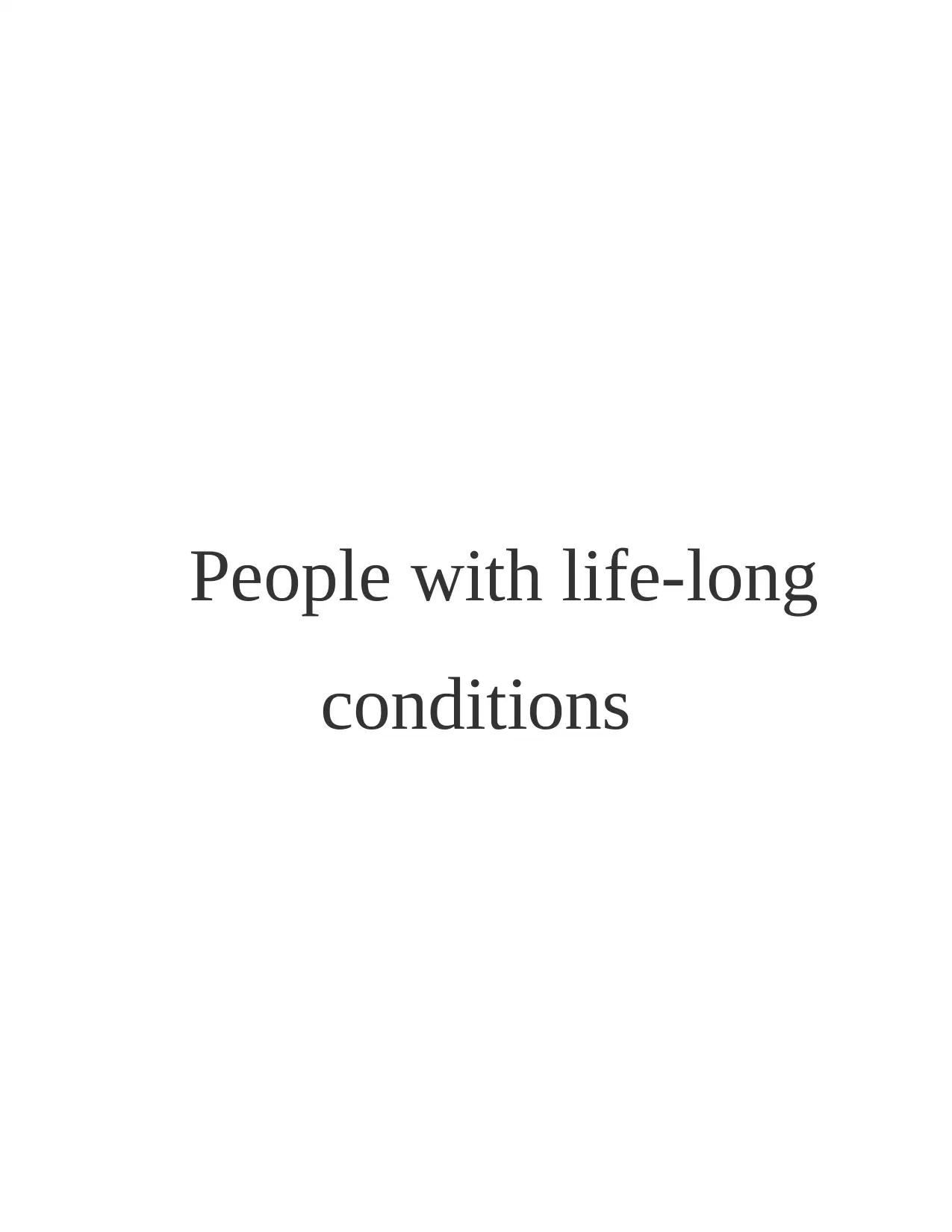
People with life-long
conditions
conditions
Paraphrase This Document
Need a fresh take? Get an instant paraphrase of this document with our AI Paraphraser
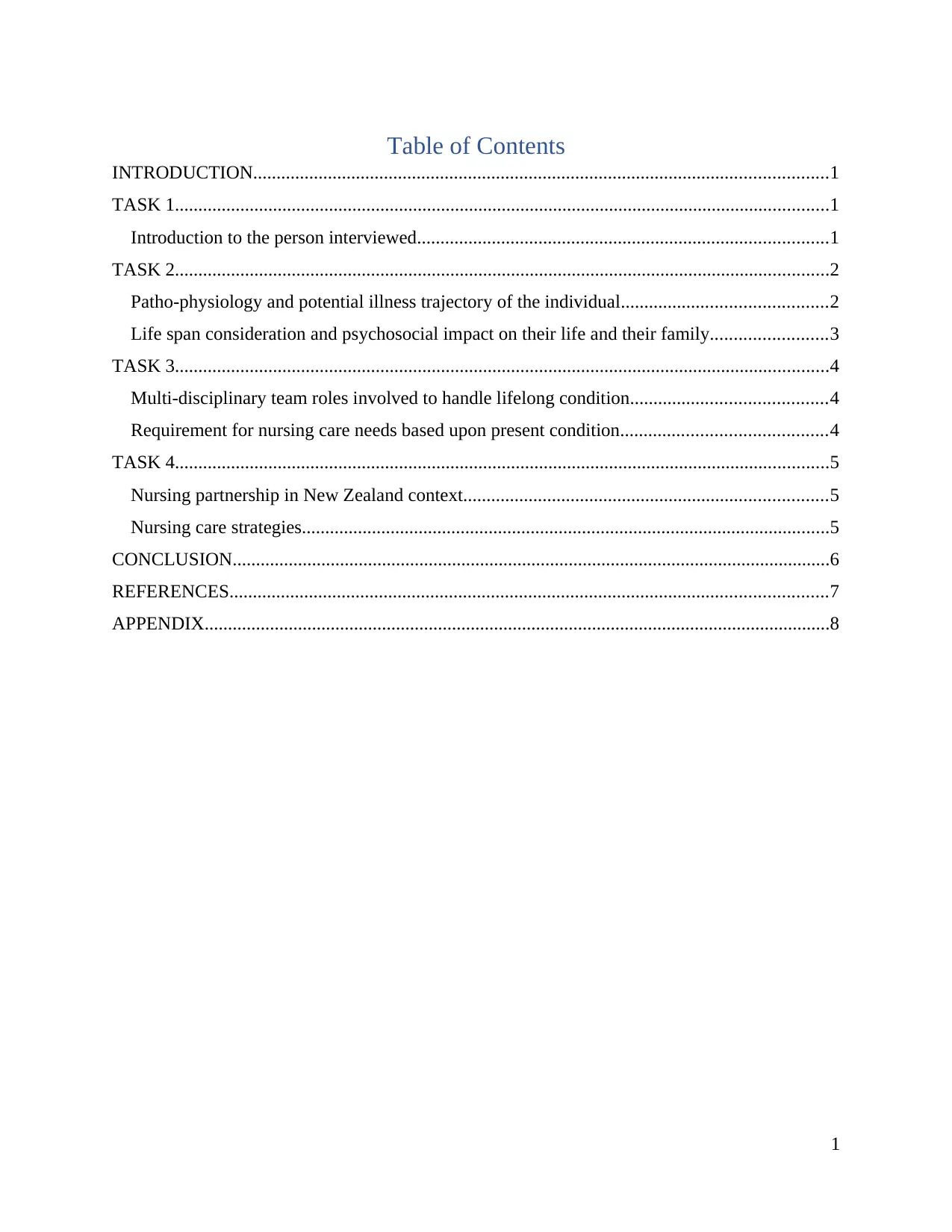
Table of Contents
INTRODUCTION...........................................................................................................................1
TASK 1............................................................................................................................................1
Introduction to the person interviewed........................................................................................1
TASK 2............................................................................................................................................2
Patho-physiology and potential illness trajectory of the individual............................................2
Life span consideration and psychosocial impact on their life and their family.........................3
TASK 3............................................................................................................................................4
Multi-disciplinary team roles involved to handle lifelong condition..........................................4
Requirement for nursing care needs based upon present condition............................................4
TASK 4............................................................................................................................................5
Nursing partnership in New Zealand context..............................................................................5
Nursing care strategies.................................................................................................................5
CONCLUSION................................................................................................................................6
REFERENCES................................................................................................................................7
APPENDIX......................................................................................................................................8
1
INTRODUCTION...........................................................................................................................1
TASK 1............................................................................................................................................1
Introduction to the person interviewed........................................................................................1
TASK 2............................................................................................................................................2
Patho-physiology and potential illness trajectory of the individual............................................2
Life span consideration and psychosocial impact on their life and their family.........................3
TASK 3............................................................................................................................................4
Multi-disciplinary team roles involved to handle lifelong condition..........................................4
Requirement for nursing care needs based upon present condition............................................4
TASK 4............................................................................................................................................5
Nursing partnership in New Zealand context..............................................................................5
Nursing care strategies.................................................................................................................5
CONCLUSION................................................................................................................................6
REFERENCES................................................................................................................................7
APPENDIX......................................................................................................................................8
1
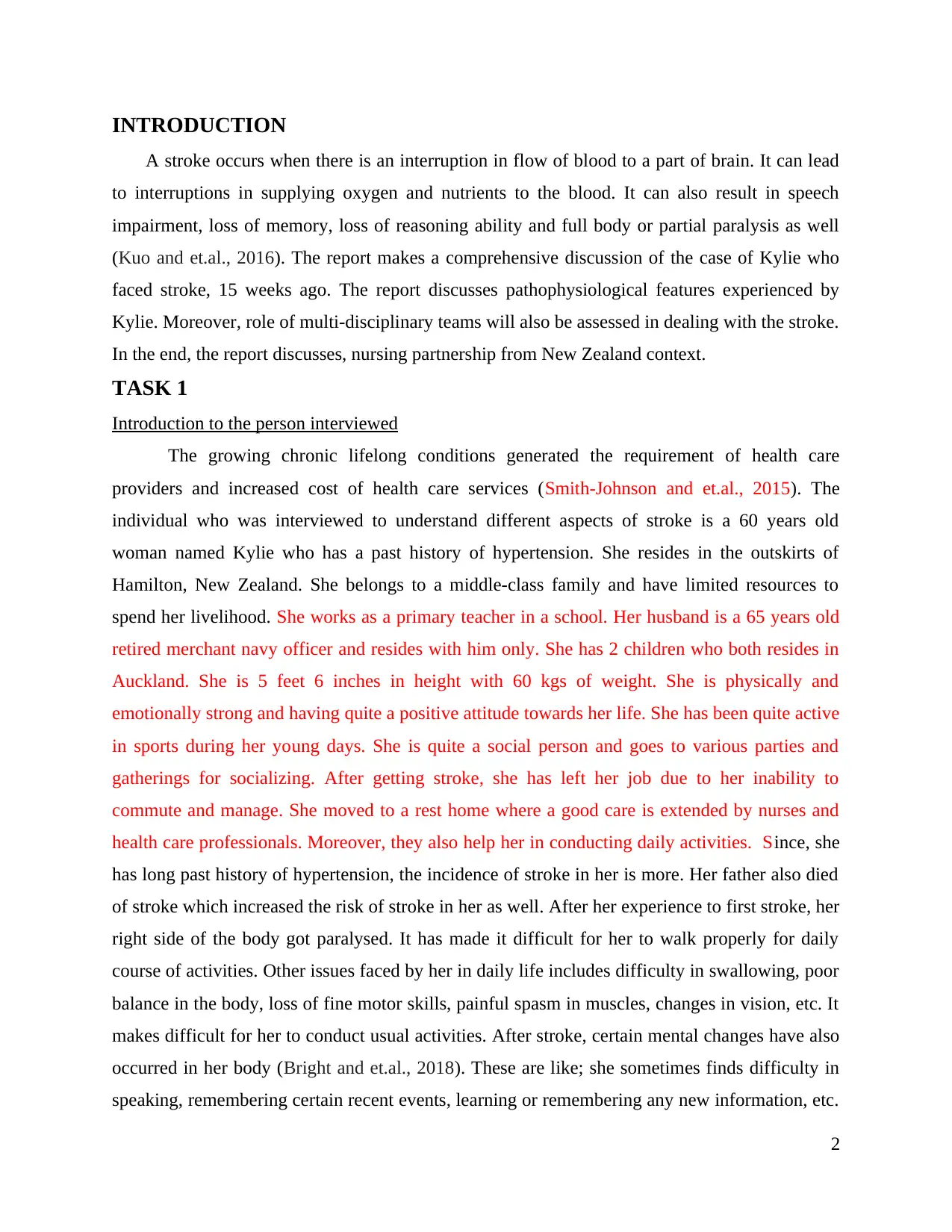
INTRODUCTION
A stroke occurs when there is an interruption in flow of blood to a part of brain. It can lead
to interruptions in supplying oxygen and nutrients to the blood. It can also result in speech
impairment, loss of memory, loss of reasoning ability and full body or partial paralysis as well
(Kuo and et.al., 2016). The report makes a comprehensive discussion of the case of Kylie who
faced stroke, 15 weeks ago. The report discusses pathophysiological features experienced by
Kylie. Moreover, role of multi-disciplinary teams will also be assessed in dealing with the stroke.
In the end, the report discusses, nursing partnership from New Zealand context.
TASK 1
Introduction to the person interviewed
The growing chronic lifelong conditions generated the requirement of health care
providers and increased cost of health care services (Smith-Johnson and et.al., 2015). The
individual who was interviewed to understand different aspects of stroke is a 60 years old
woman named Kylie who has a past history of hypertension. She resides in the outskirts of
Hamilton, New Zealand. She belongs to a middle-class family and have limited resources to
spend her livelihood. She works as a primary teacher in a school. Her husband is a 65 years old
retired merchant navy officer and resides with him only. She has 2 children who both resides in
Auckland. She is 5 feet 6 inches in height with 60 kgs of weight. She is physically and
emotionally strong and having quite a positive attitude towards her life. She has been quite active
in sports during her young days. She is quite a social person and goes to various parties and
gatherings for socializing. After getting stroke, she has left her job due to her inability to
commute and manage. She moved to a rest home where a good care is extended by nurses and
health care professionals. Moreover, they also help her in conducting daily activities. Since, she
has long past history of hypertension, the incidence of stroke in her is more. Her father also died
of stroke which increased the risk of stroke in her as well. After her experience to first stroke, her
right side of the body got paralysed. It has made it difficult for her to walk properly for daily
course of activities. Other issues faced by her in daily life includes difficulty in swallowing, poor
balance in the body, loss of fine motor skills, painful spasm in muscles, changes in vision, etc. It
makes difficult for her to conduct usual activities. After stroke, certain mental changes have also
occurred in her body (Bright and et.al., 2018). These are like; she sometimes finds difficulty in
speaking, remembering certain recent events, learning or remembering any new information, etc.
2
A stroke occurs when there is an interruption in flow of blood to a part of brain. It can lead
to interruptions in supplying oxygen and nutrients to the blood. It can also result in speech
impairment, loss of memory, loss of reasoning ability and full body or partial paralysis as well
(Kuo and et.al., 2016). The report makes a comprehensive discussion of the case of Kylie who
faced stroke, 15 weeks ago. The report discusses pathophysiological features experienced by
Kylie. Moreover, role of multi-disciplinary teams will also be assessed in dealing with the stroke.
In the end, the report discusses, nursing partnership from New Zealand context.
TASK 1
Introduction to the person interviewed
The growing chronic lifelong conditions generated the requirement of health care
providers and increased cost of health care services (Smith-Johnson and et.al., 2015). The
individual who was interviewed to understand different aspects of stroke is a 60 years old
woman named Kylie who has a past history of hypertension. She resides in the outskirts of
Hamilton, New Zealand. She belongs to a middle-class family and have limited resources to
spend her livelihood. She works as a primary teacher in a school. Her husband is a 65 years old
retired merchant navy officer and resides with him only. She has 2 children who both resides in
Auckland. She is 5 feet 6 inches in height with 60 kgs of weight. She is physically and
emotionally strong and having quite a positive attitude towards her life. She has been quite active
in sports during her young days. She is quite a social person and goes to various parties and
gatherings for socializing. After getting stroke, she has left her job due to her inability to
commute and manage. She moved to a rest home where a good care is extended by nurses and
health care professionals. Moreover, they also help her in conducting daily activities. Since, she
has long past history of hypertension, the incidence of stroke in her is more. Her father also died
of stroke which increased the risk of stroke in her as well. After her experience to first stroke, her
right side of the body got paralysed. It has made it difficult for her to walk properly for daily
course of activities. Other issues faced by her in daily life includes difficulty in swallowing, poor
balance in the body, loss of fine motor skills, painful spasm in muscles, changes in vision, etc. It
makes difficult for her to conduct usual activities. After stroke, certain mental changes have also
occurred in her body (Bright and et.al., 2018). These are like; she sometimes finds difficulty in
speaking, remembering certain recent events, learning or remembering any new information, etc.
2
⊘ This is a preview!⊘
Do you want full access?
Subscribe today to unlock all pages.

Trusted by 1+ million students worldwide
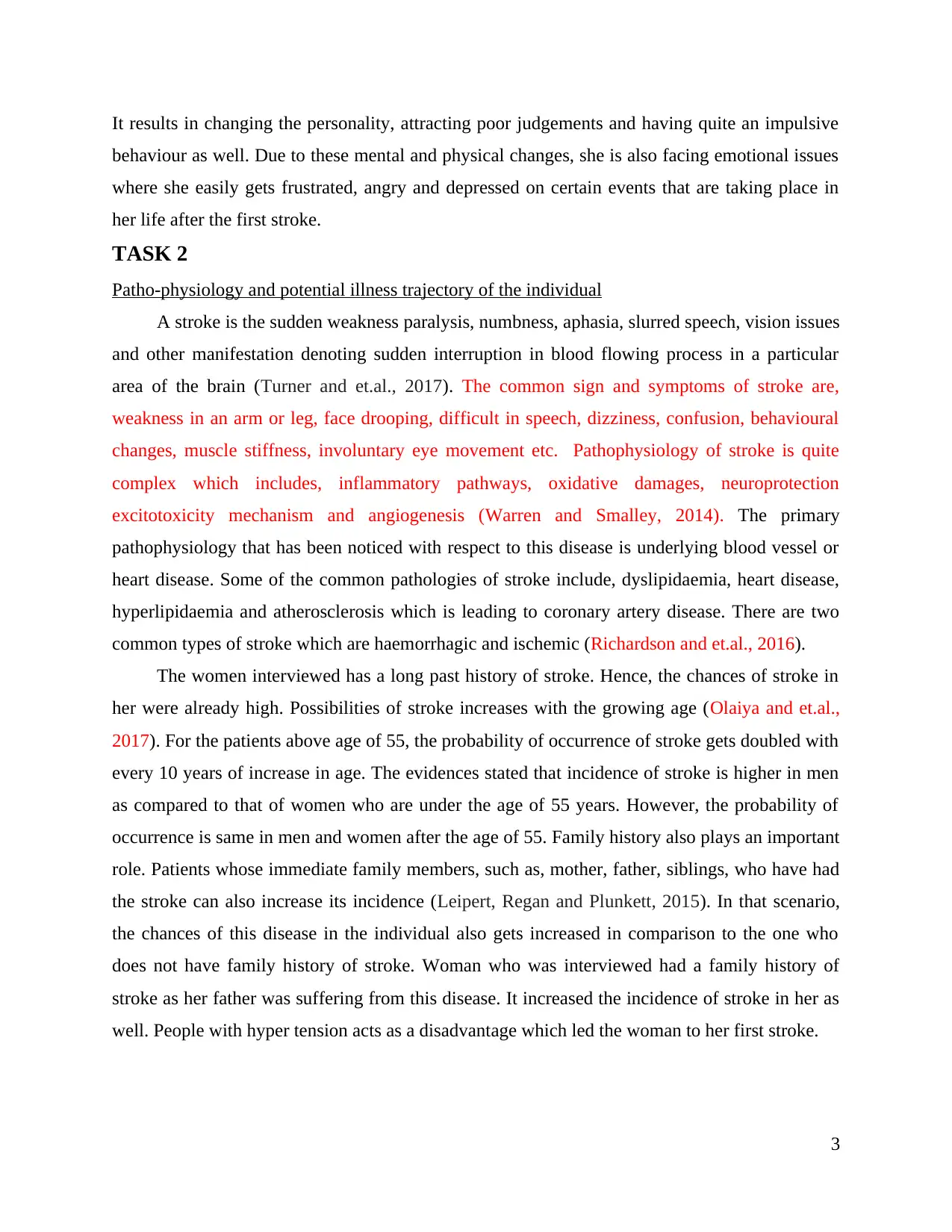
It results in changing the personality, attracting poor judgements and having quite an impulsive
behaviour as well. Due to these mental and physical changes, she is also facing emotional issues
where she easily gets frustrated, angry and depressed on certain events that are taking place in
her life after the first stroke.
TASK 2
Patho-physiology and potential illness trajectory of the individual
A stroke is the sudden weakness paralysis, numbness, aphasia, slurred speech, vision issues
and other manifestation denoting sudden interruption in blood flowing process in a particular
area of the brain (Turner and et.al., 2017). The common sign and symptoms of stroke are,
weakness in an arm or leg, face drooping, difficult in speech, dizziness, confusion, behavioural
changes, muscle stiffness, involuntary eye movement etc. Pathophysiology of stroke is quite
complex which includes, inflammatory pathways, oxidative damages, neuroprotection
excitotoxicity mechanism and angiogenesis (Warren and Smalley, 2014). The primary
pathophysiology that has been noticed with respect to this disease is underlying blood vessel or
heart disease. Some of the common pathologies of stroke include, dyslipidaemia, heart disease,
hyperlipidaemia and atherosclerosis which is leading to coronary artery disease. There are two
common types of stroke which are haemorrhagic and ischemic (Richardson and et.al., 2016).
The women interviewed has a long past history of stroke. Hence, the chances of stroke in
her were already high. Possibilities of stroke increases with the growing age (Olaiya and et.al.,
2017). For the patients above age of 55, the probability of occurrence of stroke gets doubled with
every 10 years of increase in age. The evidences stated that incidence of stroke is higher in men
as compared to that of women who are under the age of 55 years. However, the probability of
occurrence is same in men and women after the age of 55. Family history also plays an important
role. Patients whose immediate family members, such as, mother, father, siblings, who have had
the stroke can also increase its incidence (Leipert, Regan and Plunkett, 2015). In that scenario,
the chances of this disease in the individual also gets increased in comparison to the one who
does not have family history of stroke. Woman who was interviewed had a family history of
stroke as her father was suffering from this disease. It increased the incidence of stroke in her as
well. People with hyper tension acts as a disadvantage which led the woman to her first stroke.
3
behaviour as well. Due to these mental and physical changes, she is also facing emotional issues
where she easily gets frustrated, angry and depressed on certain events that are taking place in
her life after the first stroke.
TASK 2
Patho-physiology and potential illness trajectory of the individual
A stroke is the sudden weakness paralysis, numbness, aphasia, slurred speech, vision issues
and other manifestation denoting sudden interruption in blood flowing process in a particular
area of the brain (Turner and et.al., 2017). The common sign and symptoms of stroke are,
weakness in an arm or leg, face drooping, difficult in speech, dizziness, confusion, behavioural
changes, muscle stiffness, involuntary eye movement etc. Pathophysiology of stroke is quite
complex which includes, inflammatory pathways, oxidative damages, neuroprotection
excitotoxicity mechanism and angiogenesis (Warren and Smalley, 2014). The primary
pathophysiology that has been noticed with respect to this disease is underlying blood vessel or
heart disease. Some of the common pathologies of stroke include, dyslipidaemia, heart disease,
hyperlipidaemia and atherosclerosis which is leading to coronary artery disease. There are two
common types of stroke which are haemorrhagic and ischemic (Richardson and et.al., 2016).
The women interviewed has a long past history of stroke. Hence, the chances of stroke in
her were already high. Possibilities of stroke increases with the growing age (Olaiya and et.al.,
2017). For the patients above age of 55, the probability of occurrence of stroke gets doubled with
every 10 years of increase in age. The evidences stated that incidence of stroke is higher in men
as compared to that of women who are under the age of 55 years. However, the probability of
occurrence is same in men and women after the age of 55. Family history also plays an important
role. Patients whose immediate family members, such as, mother, father, siblings, who have had
the stroke can also increase its incidence (Leipert, Regan and Plunkett, 2015). In that scenario,
the chances of this disease in the individual also gets increased in comparison to the one who
does not have family history of stroke. Woman who was interviewed had a family history of
stroke as her father was suffering from this disease. It increased the incidence of stroke in her as
well. People with hyper tension acts as a disadvantage which led the woman to her first stroke.
3
Paraphrase This Document
Need a fresh take? Get an instant paraphrase of this document with our AI Paraphraser
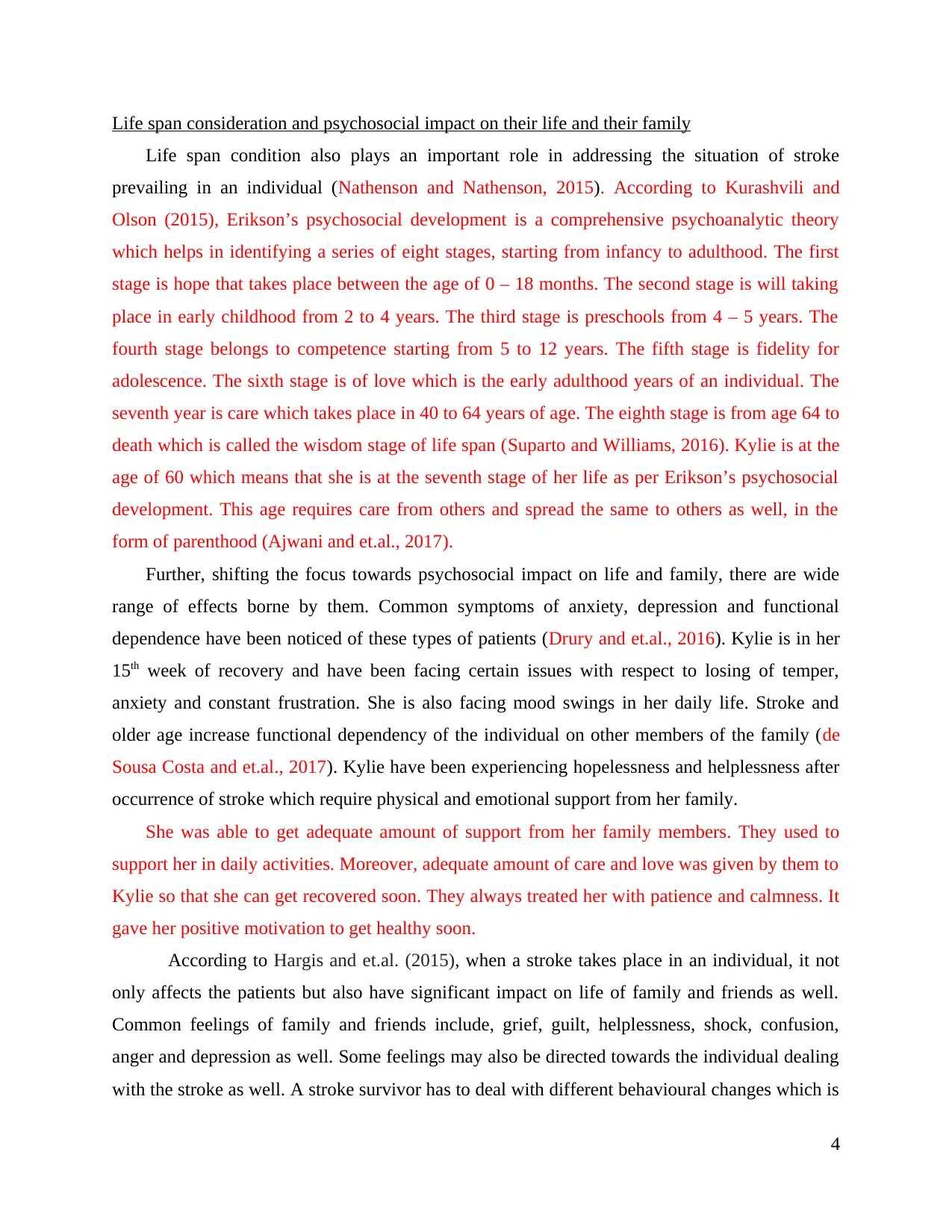
Life span consideration and psychosocial impact on their life and their family
Life span condition also plays an important role in addressing the situation of stroke
prevailing in an individual (Nathenson and Nathenson, 2015). According to Kurashvili and
Olson (2015), Erikson’s psychosocial development is a comprehensive psychoanalytic theory
which helps in identifying a series of eight stages, starting from infancy to adulthood. The first
stage is hope that takes place between the age of 0 – 18 months. The second stage is will taking
place in early childhood from 2 to 4 years. The third stage is preschools from 4 – 5 years. The
fourth stage belongs to competence starting from 5 to 12 years. The fifth stage is fidelity for
adolescence. The sixth stage is of love which is the early adulthood years of an individual. The
seventh year is care which takes place in 40 to 64 years of age. The eighth stage is from age 64 to
death which is called the wisdom stage of life span (Suparto and Williams, 2016). Kylie is at the
age of 60 which means that she is at the seventh stage of her life as per Erikson’s psychosocial
development. This age requires care from others and spread the same to others as well, in the
form of parenthood (Ajwani and et.al., 2017).
Further, shifting the focus towards psychosocial impact on life and family, there are wide
range of effects borne by them. Common symptoms of anxiety, depression and functional
dependence have been noticed of these types of patients (Drury and et.al., 2016). Kylie is in her
15th week of recovery and have been facing certain issues with respect to losing of temper,
anxiety and constant frustration. She is also facing mood swings in her daily life. Stroke and
older age increase functional dependency of the individual on other members of the family (de
Sousa Costa and et.al., 2017). Kylie have been experiencing hopelessness and helplessness after
occurrence of stroke which require physical and emotional support from her family.
She was able to get adequate amount of support from her family members. They used to
support her in daily activities. Moreover, adequate amount of care and love was given by them to
Kylie so that she can get recovered soon. They always treated her with patience and calmness. It
gave her positive motivation to get healthy soon.
According to Hargis and et.al. (2015), when a stroke takes place in an individual, it not
only affects the patients but also have significant impact on life of family and friends as well.
Common feelings of family and friends include, grief, guilt, helplessness, shock, confusion,
anger and depression as well. Some feelings may also be directed towards the individual dealing
with the stroke as well. A stroke survivor has to deal with different behavioural changes which is
4
Life span condition also plays an important role in addressing the situation of stroke
prevailing in an individual (Nathenson and Nathenson, 2015). According to Kurashvili and
Olson (2015), Erikson’s psychosocial development is a comprehensive psychoanalytic theory
which helps in identifying a series of eight stages, starting from infancy to adulthood. The first
stage is hope that takes place between the age of 0 – 18 months. The second stage is will taking
place in early childhood from 2 to 4 years. The third stage is preschools from 4 – 5 years. The
fourth stage belongs to competence starting from 5 to 12 years. The fifth stage is fidelity for
adolescence. The sixth stage is of love which is the early adulthood years of an individual. The
seventh year is care which takes place in 40 to 64 years of age. The eighth stage is from age 64 to
death which is called the wisdom stage of life span (Suparto and Williams, 2016). Kylie is at the
age of 60 which means that she is at the seventh stage of her life as per Erikson’s psychosocial
development. This age requires care from others and spread the same to others as well, in the
form of parenthood (Ajwani and et.al., 2017).
Further, shifting the focus towards psychosocial impact on life and family, there are wide
range of effects borne by them. Common symptoms of anxiety, depression and functional
dependence have been noticed of these types of patients (Drury and et.al., 2016). Kylie is in her
15th week of recovery and have been facing certain issues with respect to losing of temper,
anxiety and constant frustration. She is also facing mood swings in her daily life. Stroke and
older age increase functional dependency of the individual on other members of the family (de
Sousa Costa and et.al., 2017). Kylie have been experiencing hopelessness and helplessness after
occurrence of stroke which require physical and emotional support from her family.
She was able to get adequate amount of support from her family members. They used to
support her in daily activities. Moreover, adequate amount of care and love was given by them to
Kylie so that she can get recovered soon. They always treated her with patience and calmness. It
gave her positive motivation to get healthy soon.
According to Hargis and et.al. (2015), when a stroke takes place in an individual, it not
only affects the patients but also have significant impact on life of family and friends as well.
Common feelings of family and friends include, grief, guilt, helplessness, shock, confusion,
anger and depression as well. Some feelings may also be directed towards the individual dealing
with the stroke as well. A stroke survivor has to deal with different behavioural changes which is
4
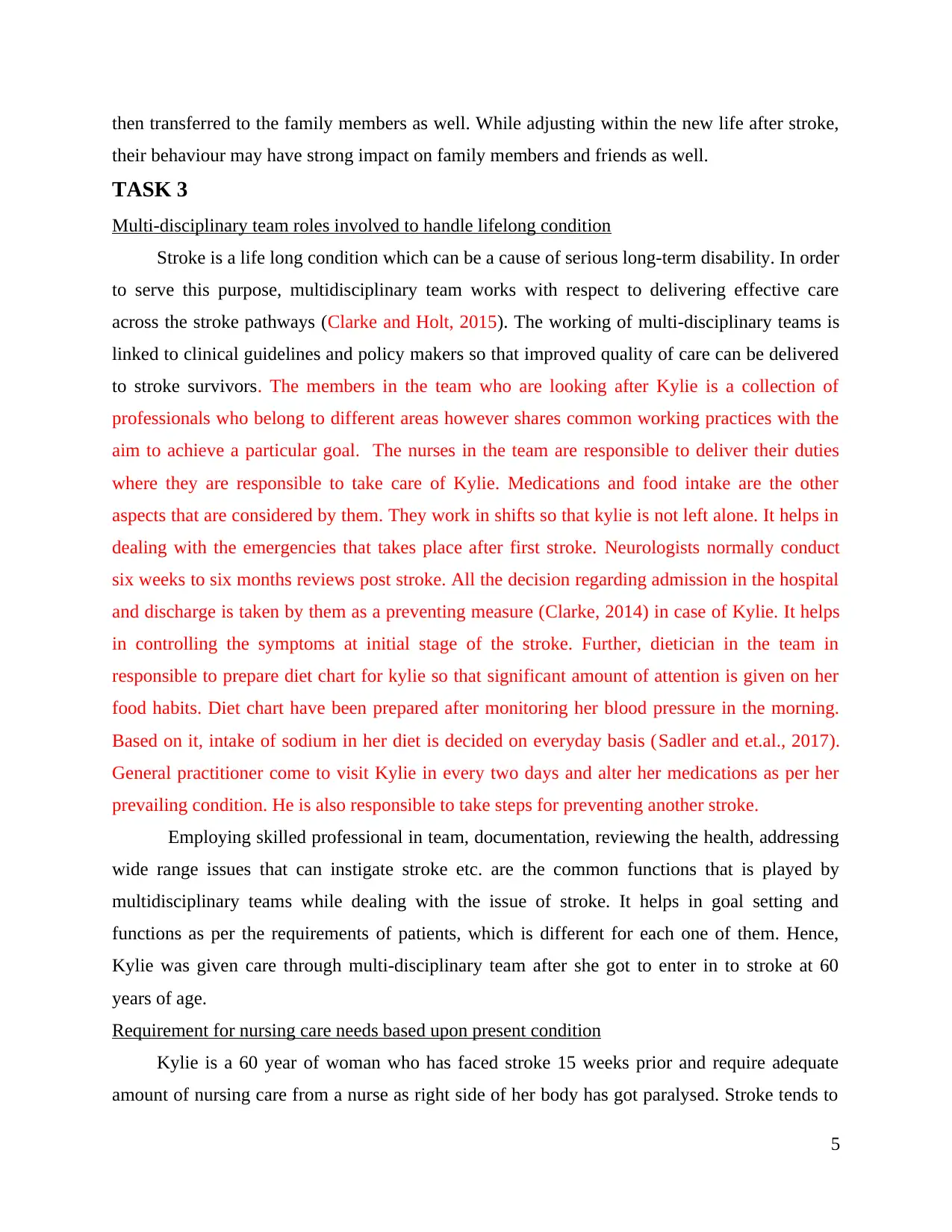
then transferred to the family members as well. While adjusting within the new life after stroke,
their behaviour may have strong impact on family members and friends as well.
TASK 3
Multi-disciplinary team roles involved to handle lifelong condition
Stroke is a life long condition which can be a cause of serious long-term disability. In order
to serve this purpose, multidisciplinary team works with respect to delivering effective care
across the stroke pathways (Clarke and Holt, 2015). The working of multi-disciplinary teams is
linked to clinical guidelines and policy makers so that improved quality of care can be delivered
to stroke survivors. The members in the team who are looking after Kylie is a collection of
professionals who belong to different areas however shares common working practices with the
aim to achieve a particular goal. The nurses in the team are responsible to deliver their duties
where they are responsible to take care of Kylie. Medications and food intake are the other
aspects that are considered by them. They work in shifts so that kylie is not left alone. It helps in
dealing with the emergencies that takes place after first stroke. Neurologists normally conduct
six weeks to six months reviews post stroke. All the decision regarding admission in the hospital
and discharge is taken by them as a preventing measure (Clarke, 2014) in case of Kylie. It helps
in controlling the symptoms at initial stage of the stroke. Further, dietician in the team in
responsible to prepare diet chart for kylie so that significant amount of attention is given on her
food habits. Diet chart have been prepared after monitoring her blood pressure in the morning.
Based on it, intake of sodium in her diet is decided on everyday basis (Sadler and et.al., 2017).
General practitioner come to visit Kylie in every two days and alter her medications as per her
prevailing condition. He is also responsible to take steps for preventing another stroke.
Employing skilled professional in team, documentation, reviewing the health, addressing
wide range issues that can instigate stroke etc. are the common functions that is played by
multidisciplinary teams while dealing with the issue of stroke. It helps in goal setting and
functions as per the requirements of patients, which is different for each one of them. Hence,
Kylie was given care through multi-disciplinary team after she got to enter in to stroke at 60
years of age.
Requirement for nursing care needs based upon present condition
Kylie is a 60 year of woman who has faced stroke 15 weeks prior and require adequate
amount of nursing care from a nurse as right side of her body has got paralysed. Stroke tends to
5
their behaviour may have strong impact on family members and friends as well.
TASK 3
Multi-disciplinary team roles involved to handle lifelong condition
Stroke is a life long condition which can be a cause of serious long-term disability. In order
to serve this purpose, multidisciplinary team works with respect to delivering effective care
across the stroke pathways (Clarke and Holt, 2015). The working of multi-disciplinary teams is
linked to clinical guidelines and policy makers so that improved quality of care can be delivered
to stroke survivors. The members in the team who are looking after Kylie is a collection of
professionals who belong to different areas however shares common working practices with the
aim to achieve a particular goal. The nurses in the team are responsible to deliver their duties
where they are responsible to take care of Kylie. Medications and food intake are the other
aspects that are considered by them. They work in shifts so that kylie is not left alone. It helps in
dealing with the emergencies that takes place after first stroke. Neurologists normally conduct
six weeks to six months reviews post stroke. All the decision regarding admission in the hospital
and discharge is taken by them as a preventing measure (Clarke, 2014) in case of Kylie. It helps
in controlling the symptoms at initial stage of the stroke. Further, dietician in the team in
responsible to prepare diet chart for kylie so that significant amount of attention is given on her
food habits. Diet chart have been prepared after monitoring her blood pressure in the morning.
Based on it, intake of sodium in her diet is decided on everyday basis (Sadler and et.al., 2017).
General practitioner come to visit Kylie in every two days and alter her medications as per her
prevailing condition. He is also responsible to take steps for preventing another stroke.
Employing skilled professional in team, documentation, reviewing the health, addressing
wide range issues that can instigate stroke etc. are the common functions that is played by
multidisciplinary teams while dealing with the issue of stroke. It helps in goal setting and
functions as per the requirements of patients, which is different for each one of them. Hence,
Kylie was given care through multi-disciplinary team after she got to enter in to stroke at 60
years of age.
Requirement for nursing care needs based upon present condition
Kylie is a 60 year of woman who has faced stroke 15 weeks prior and require adequate
amount of nursing care from a nurse as right side of her body has got paralysed. Stroke tends to
5
⊘ This is a preview!⊘
Do you want full access?
Subscribe today to unlock all pages.

Trusted by 1+ million students worldwide
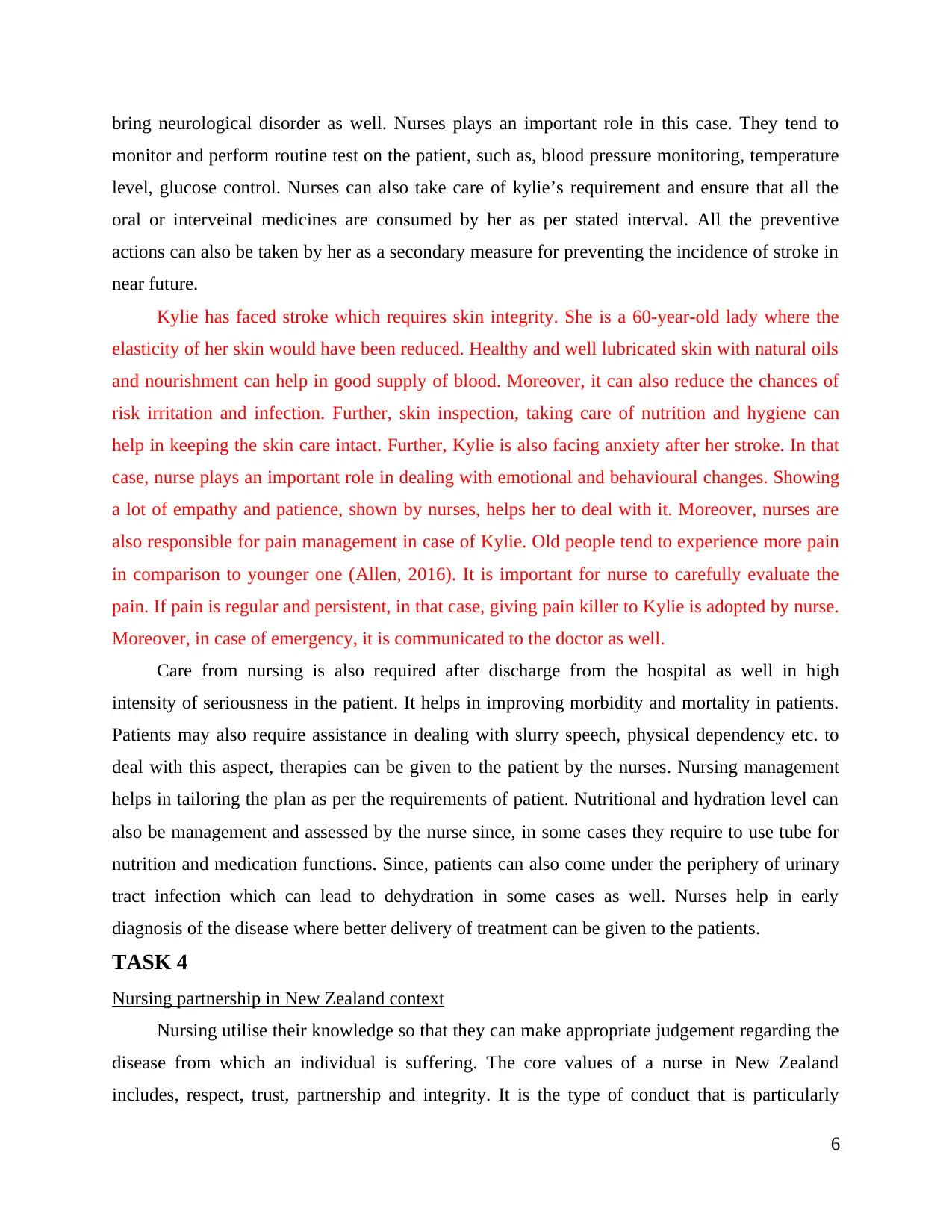
bring neurological disorder as well. Nurses plays an important role in this case. They tend to
monitor and perform routine test on the patient, such as, blood pressure monitoring, temperature
level, glucose control. Nurses can also take care of kylie’s requirement and ensure that all the
oral or interveinal medicines are consumed by her as per stated interval. All the preventive
actions can also be taken by her as a secondary measure for preventing the incidence of stroke in
near future.
Kylie has faced stroke which requires skin integrity. She is a 60-year-old lady where the
elasticity of her skin would have been reduced. Healthy and well lubricated skin with natural oils
and nourishment can help in good supply of blood. Moreover, it can also reduce the chances of
risk irritation and infection. Further, skin inspection, taking care of nutrition and hygiene can
help in keeping the skin care intact. Further, Kylie is also facing anxiety after her stroke. In that
case, nurse plays an important role in dealing with emotional and behavioural changes. Showing
a lot of empathy and patience, shown by nurses, helps her to deal with it. Moreover, nurses are
also responsible for pain management in case of Kylie. Old people tend to experience more pain
in comparison to younger one (Allen, 2016). It is important for nurse to carefully evaluate the
pain. If pain is regular and persistent, in that case, giving pain killer to Kylie is adopted by nurse.
Moreover, in case of emergency, it is communicated to the doctor as well.
Care from nursing is also required after discharge from the hospital as well in high
intensity of seriousness in the patient. It helps in improving morbidity and mortality in patients.
Patients may also require assistance in dealing with slurry speech, physical dependency etc. to
deal with this aspect, therapies can be given to the patient by the nurses. Nursing management
helps in tailoring the plan as per the requirements of patient. Nutritional and hydration level can
also be management and assessed by the nurse since, in some cases they require to use tube for
nutrition and medication functions. Since, patients can also come under the periphery of urinary
tract infection which can lead to dehydration in some cases as well. Nurses help in early
diagnosis of the disease where better delivery of treatment can be given to the patients.
TASK 4
Nursing partnership in New Zealand context
Nursing utilise their knowledge so that they can make appropriate judgement regarding the
disease from which an individual is suffering. The core values of a nurse in New Zealand
includes, respect, trust, partnership and integrity. It is the type of conduct that is particularly
6
monitor and perform routine test on the patient, such as, blood pressure monitoring, temperature
level, glucose control. Nurses can also take care of kylie’s requirement and ensure that all the
oral or interveinal medicines are consumed by her as per stated interval. All the preventive
actions can also be taken by her as a secondary measure for preventing the incidence of stroke in
near future.
Kylie has faced stroke which requires skin integrity. She is a 60-year-old lady where the
elasticity of her skin would have been reduced. Healthy and well lubricated skin with natural oils
and nourishment can help in good supply of blood. Moreover, it can also reduce the chances of
risk irritation and infection. Further, skin inspection, taking care of nutrition and hygiene can
help in keeping the skin care intact. Further, Kylie is also facing anxiety after her stroke. In that
case, nurse plays an important role in dealing with emotional and behavioural changes. Showing
a lot of empathy and patience, shown by nurses, helps her to deal with it. Moreover, nurses are
also responsible for pain management in case of Kylie. Old people tend to experience more pain
in comparison to younger one (Allen, 2016). It is important for nurse to carefully evaluate the
pain. If pain is regular and persistent, in that case, giving pain killer to Kylie is adopted by nurse.
Moreover, in case of emergency, it is communicated to the doctor as well.
Care from nursing is also required after discharge from the hospital as well in high
intensity of seriousness in the patient. It helps in improving morbidity and mortality in patients.
Patients may also require assistance in dealing with slurry speech, physical dependency etc. to
deal with this aspect, therapies can be given to the patient by the nurses. Nursing management
helps in tailoring the plan as per the requirements of patient. Nutritional and hydration level can
also be management and assessed by the nurse since, in some cases they require to use tube for
nutrition and medication functions. Since, patients can also come under the periphery of urinary
tract infection which can lead to dehydration in some cases as well. Nurses help in early
diagnosis of the disease where better delivery of treatment can be given to the patients.
TASK 4
Nursing partnership in New Zealand context
Nursing utilise their knowledge so that they can make appropriate judgement regarding the
disease from which an individual is suffering. The core values of a nurse in New Zealand
includes, respect, trust, partnership and integrity. It is the type of conduct that is particularly
6
Paraphrase This Document
Need a fresh take? Get an instant paraphrase of this document with our AI Paraphraser
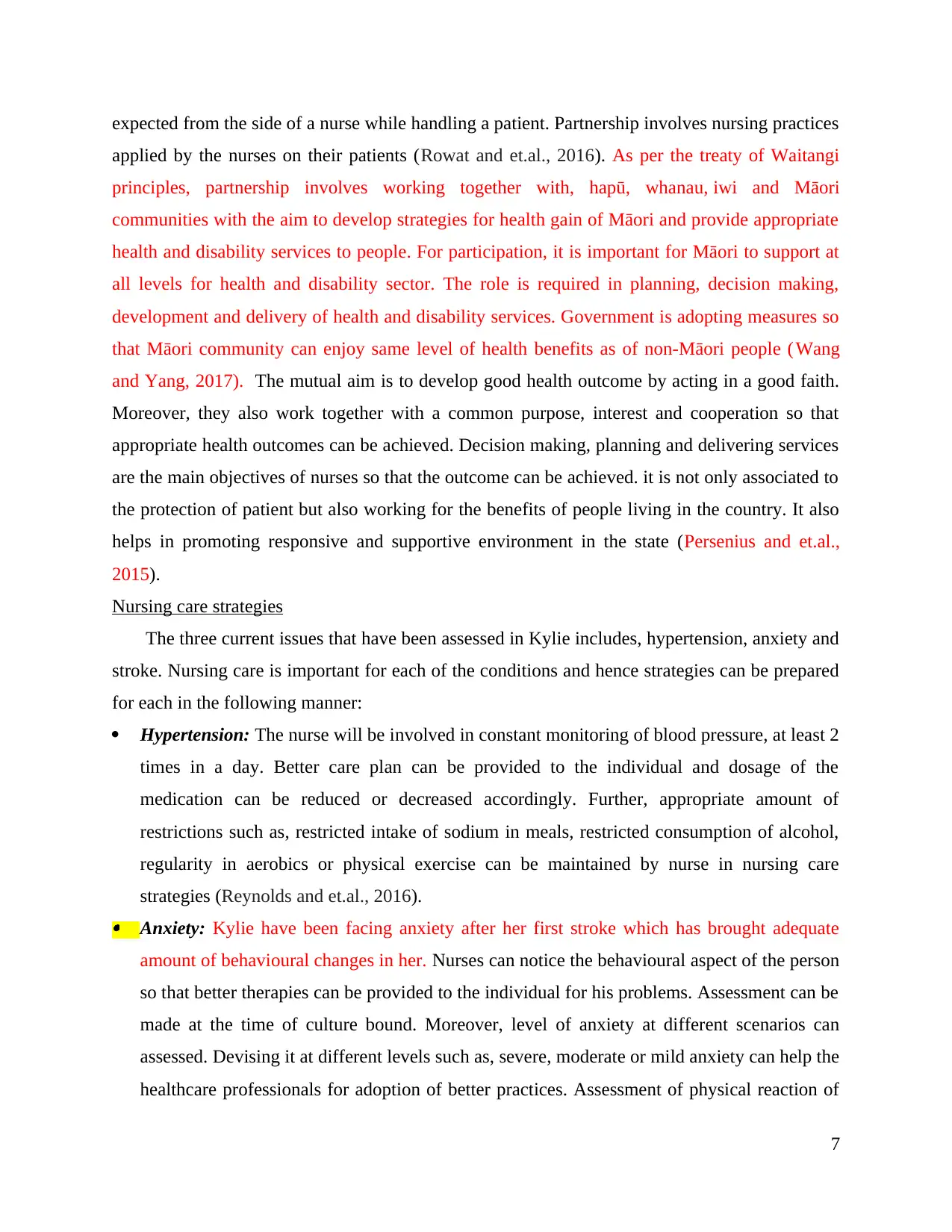
expected from the side of a nurse while handling a patient. Partnership involves nursing practices
applied by the nurses on their patients (Rowat and et.al., 2016). As per the treaty of Waitangi
principles, partnership involves working together with, hapū, whanau, iwi and Māori
communities with the aim to develop strategies for health gain of Māori and provide appropriate
health and disability services to people. For participation, it is important for Māori to support at
all levels for health and disability sector. The role is required in planning, decision making,
development and delivery of health and disability services. Government is adopting measures so
that Māori community can enjoy same level of health benefits as of non-Māori people ( Wang
and Yang, 2017). The mutual aim is to develop good health outcome by acting in a good faith.
Moreover, they also work together with a common purpose, interest and cooperation so that
appropriate health outcomes can be achieved. Decision making, planning and delivering services
are the main objectives of nurses so that the outcome can be achieved. it is not only associated to
the protection of patient but also working for the benefits of people living in the country. It also
helps in promoting responsive and supportive environment in the state (Persenius and et.al.,
2015).
Nursing care strategies
The three current issues that have been assessed in Kylie includes, hypertension, anxiety and
stroke. Nursing care is important for each of the conditions and hence strategies can be prepared
for each in the following manner:
Hypertension: The nurse will be involved in constant monitoring of blood pressure, at least 2
times in a day. Better care plan can be provided to the individual and dosage of the
medication can be reduced or decreased accordingly. Further, appropriate amount of
restrictions such as, restricted intake of sodium in meals, restricted consumption of alcohol,
regularity in aerobics or physical exercise can be maintained by nurse in nursing care
strategies (Reynolds and et.al., 2016). Anxiety: Kylie have been facing anxiety after her first stroke which has brought adequate
amount of behavioural changes in her. Nurses can notice the behavioural aspect of the person
so that better therapies can be provided to the individual for his problems. Assessment can be
made at the time of culture bound. Moreover, level of anxiety at different scenarios can
assessed. Devising it at different levels such as, severe, moderate or mild anxiety can help the
healthcare professionals for adoption of better practices. Assessment of physical reaction of
7
applied by the nurses on their patients (Rowat and et.al., 2016). As per the treaty of Waitangi
principles, partnership involves working together with, hapū, whanau, iwi and Māori
communities with the aim to develop strategies for health gain of Māori and provide appropriate
health and disability services to people. For participation, it is important for Māori to support at
all levels for health and disability sector. The role is required in planning, decision making,
development and delivery of health and disability services. Government is adopting measures so
that Māori community can enjoy same level of health benefits as of non-Māori people ( Wang
and Yang, 2017). The mutual aim is to develop good health outcome by acting in a good faith.
Moreover, they also work together with a common purpose, interest and cooperation so that
appropriate health outcomes can be achieved. Decision making, planning and delivering services
are the main objectives of nurses so that the outcome can be achieved. it is not only associated to
the protection of patient but also working for the benefits of people living in the country. It also
helps in promoting responsive and supportive environment in the state (Persenius and et.al.,
2015).
Nursing care strategies
The three current issues that have been assessed in Kylie includes, hypertension, anxiety and
stroke. Nursing care is important for each of the conditions and hence strategies can be prepared
for each in the following manner:
Hypertension: The nurse will be involved in constant monitoring of blood pressure, at least 2
times in a day. Better care plan can be provided to the individual and dosage of the
medication can be reduced or decreased accordingly. Further, appropriate amount of
restrictions such as, restricted intake of sodium in meals, restricted consumption of alcohol,
regularity in aerobics or physical exercise can be maintained by nurse in nursing care
strategies (Reynolds and et.al., 2016). Anxiety: Kylie have been facing anxiety after her first stroke which has brought adequate
amount of behavioural changes in her. Nurses can notice the behavioural aspect of the person
so that better therapies can be provided to the individual for his problems. Assessment can be
made at the time of culture bound. Moreover, level of anxiety at different scenarios can
assessed. Devising it at different levels such as, severe, moderate or mild anxiety can help the
healthcare professionals for adoption of better practices. Assessment of physical reaction of
7
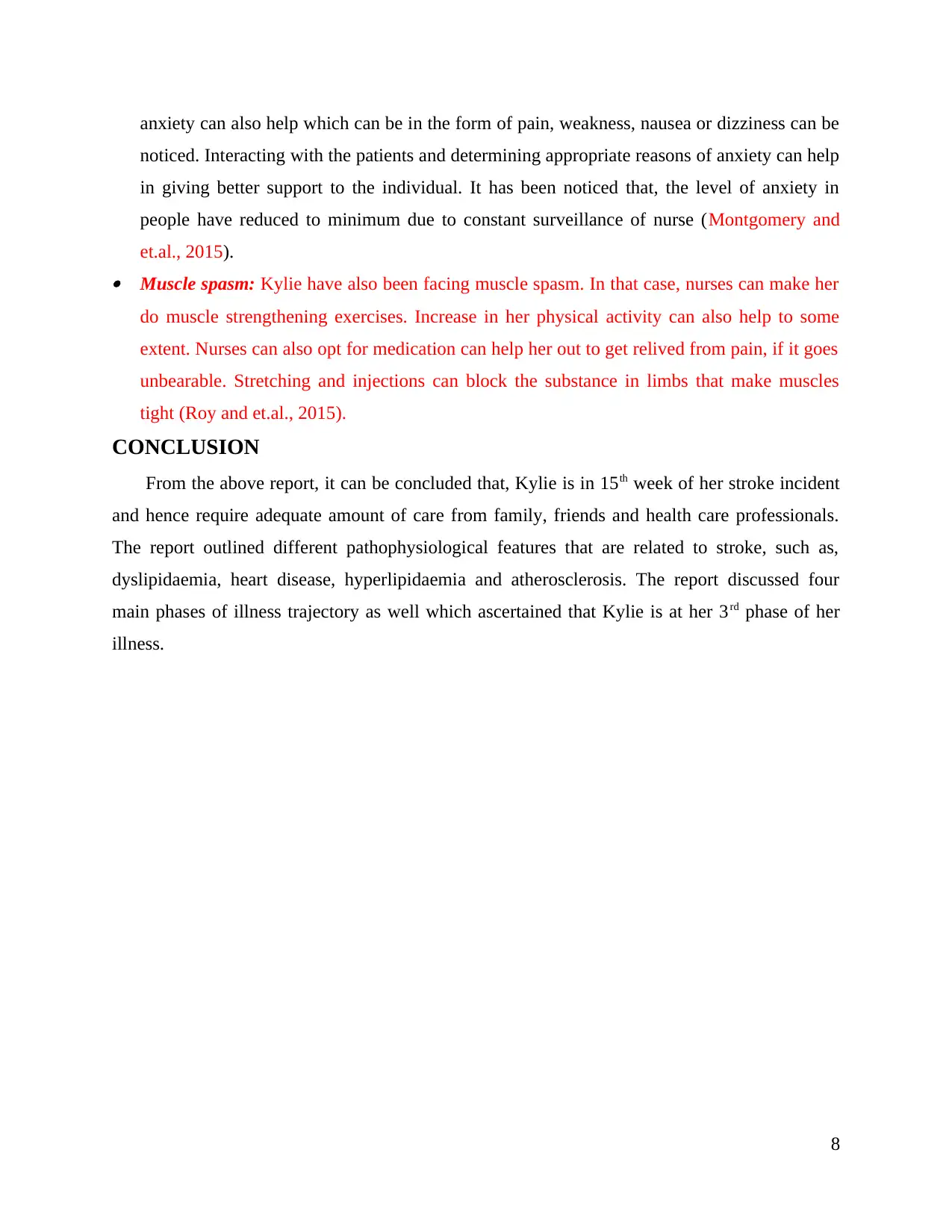
anxiety can also help which can be in the form of pain, weakness, nausea or dizziness can be
noticed. Interacting with the patients and determining appropriate reasons of anxiety can help
in giving better support to the individual. It has been noticed that, the level of anxiety in
people have reduced to minimum due to constant surveillance of nurse (Montgomery and
et.al., 2015). Muscle spasm: Kylie have also been facing muscle spasm. In that case, nurses can make her
do muscle strengthening exercises. Increase in her physical activity can also help to some
extent. Nurses can also opt for medication can help her out to get relived from pain, if it goes
unbearable. Stretching and injections can block the substance in limbs that make muscles
tight (Roy and et.al., 2015).
CONCLUSION
From the above report, it can be concluded that, Kylie is in 15th week of her stroke incident
and hence require adequate amount of care from family, friends and health care professionals.
The report outlined different pathophysiological features that are related to stroke, such as,
dyslipidaemia, heart disease, hyperlipidaemia and atherosclerosis. The report discussed four
main phases of illness trajectory as well which ascertained that Kylie is at her 3rd phase of her
illness.
8
noticed. Interacting with the patients and determining appropriate reasons of anxiety can help
in giving better support to the individual. It has been noticed that, the level of anxiety in
people have reduced to minimum due to constant surveillance of nurse (Montgomery and
et.al., 2015). Muscle spasm: Kylie have also been facing muscle spasm. In that case, nurses can make her
do muscle strengthening exercises. Increase in her physical activity can also help to some
extent. Nurses can also opt for medication can help her out to get relived from pain, if it goes
unbearable. Stretching and injections can block the substance in limbs that make muscles
tight (Roy and et.al., 2015).
CONCLUSION
From the above report, it can be concluded that, Kylie is in 15th week of her stroke incident
and hence require adequate amount of care from family, friends and health care professionals.
The report outlined different pathophysiological features that are related to stroke, such as,
dyslipidaemia, heart disease, hyperlipidaemia and atherosclerosis. The report discussed four
main phases of illness trajectory as well which ascertained that Kylie is at her 3rd phase of her
illness.
8
⊘ This is a preview!⊘
Do you want full access?
Subscribe today to unlock all pages.

Trusted by 1+ million students worldwide
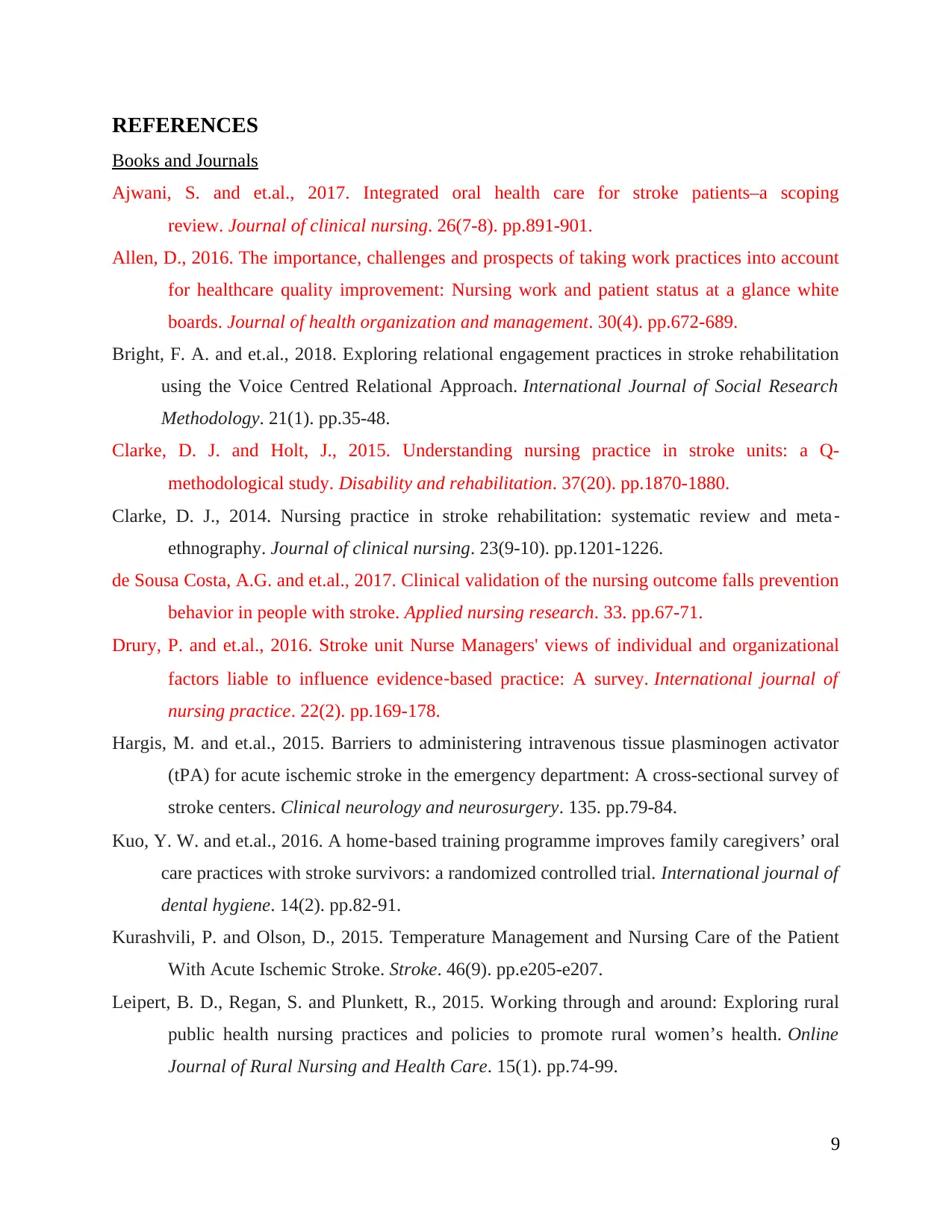
REFERENCES
Books and Journals
Ajwani, S. and et.al., 2017. Integrated oral health care for stroke patients–a scoping
review. Journal of clinical nursing. 26(7-8). pp.891-901.
Allen, D., 2016. The importance, challenges and prospects of taking work practices into account
for healthcare quality improvement: Nursing work and patient status at a glance white
boards. Journal of health organization and management. 30(4). pp.672-689.
Bright, F. A. and et.al., 2018. Exploring relational engagement practices in stroke rehabilitation
using the Voice Centred Relational Approach. International Journal of Social Research
Methodology. 21(1). pp.35-48.
Clarke, D. J. and Holt, J., 2015. Understanding nursing practice in stroke units: a Q-
methodological study. Disability and rehabilitation. 37(20). pp.1870-1880.
Clarke, D. J., 2014. Nursing practice in stroke rehabilitation: systematic review and meta‐
ethnography. Journal of clinical nursing. 23(9-10). pp.1201-1226.
de Sousa Costa, A.G. and et.al., 2017. Clinical validation of the nursing outcome falls prevention
behavior in people with stroke. Applied nursing research. 33. pp.67-71.
Drury, P. and et.al., 2016. Stroke unit Nurse Managers' views of individual and organizational
factors liable to influence evidence‐based practice: A survey. International journal of
nursing practice. 22(2). pp.169-178.
Hargis, M. and et.al., 2015. Barriers to administering intravenous tissue plasminogen activator
(tPA) for acute ischemic stroke in the emergency department: A cross-sectional survey of
stroke centers. Clinical neurology and neurosurgery. 135. pp.79-84.
Kuo, Y. W. and et.al., 2016. A home‐based training programme improves family caregivers’ oral
care practices with stroke survivors: a randomized controlled trial. International journal of
dental hygiene. 14(2). pp.82-91.
Kurashvili, P. and Olson, D., 2015. Temperature Management and Nursing Care of the Patient
With Acute Ischemic Stroke. Stroke. 46(9). pp.e205-e207.
Leipert, B. D., Regan, S. and Plunkett, R., 2015. Working through and around: Exploring rural
public health nursing practices and policies to promote rural women’s health. Online
Journal of Rural Nursing and Health Care. 15(1). pp.74-99.
9
Books and Journals
Ajwani, S. and et.al., 2017. Integrated oral health care for stroke patients–a scoping
review. Journal of clinical nursing. 26(7-8). pp.891-901.
Allen, D., 2016. The importance, challenges and prospects of taking work practices into account
for healthcare quality improvement: Nursing work and patient status at a glance white
boards. Journal of health organization and management. 30(4). pp.672-689.
Bright, F. A. and et.al., 2018. Exploring relational engagement practices in stroke rehabilitation
using the Voice Centred Relational Approach. International Journal of Social Research
Methodology. 21(1). pp.35-48.
Clarke, D. J. and Holt, J., 2015. Understanding nursing practice in stroke units: a Q-
methodological study. Disability and rehabilitation. 37(20). pp.1870-1880.
Clarke, D. J., 2014. Nursing practice in stroke rehabilitation: systematic review and meta‐
ethnography. Journal of clinical nursing. 23(9-10). pp.1201-1226.
de Sousa Costa, A.G. and et.al., 2017. Clinical validation of the nursing outcome falls prevention
behavior in people with stroke. Applied nursing research. 33. pp.67-71.
Drury, P. and et.al., 2016. Stroke unit Nurse Managers' views of individual and organizational
factors liable to influence evidence‐based practice: A survey. International journal of
nursing practice. 22(2). pp.169-178.
Hargis, M. and et.al., 2015. Barriers to administering intravenous tissue plasminogen activator
(tPA) for acute ischemic stroke in the emergency department: A cross-sectional survey of
stroke centers. Clinical neurology and neurosurgery. 135. pp.79-84.
Kuo, Y. W. and et.al., 2016. A home‐based training programme improves family caregivers’ oral
care practices with stroke survivors: a randomized controlled trial. International journal of
dental hygiene. 14(2). pp.82-91.
Kurashvili, P. and Olson, D., 2015. Temperature Management and Nursing Care of the Patient
With Acute Ischemic Stroke. Stroke. 46(9). pp.e205-e207.
Leipert, B. D., Regan, S. and Plunkett, R., 2015. Working through and around: Exploring rural
public health nursing practices and policies to promote rural women’s health. Online
Journal of Rural Nursing and Health Care. 15(1). pp.74-99.
9
Paraphrase This Document
Need a fresh take? Get an instant paraphrase of this document with our AI Paraphraser
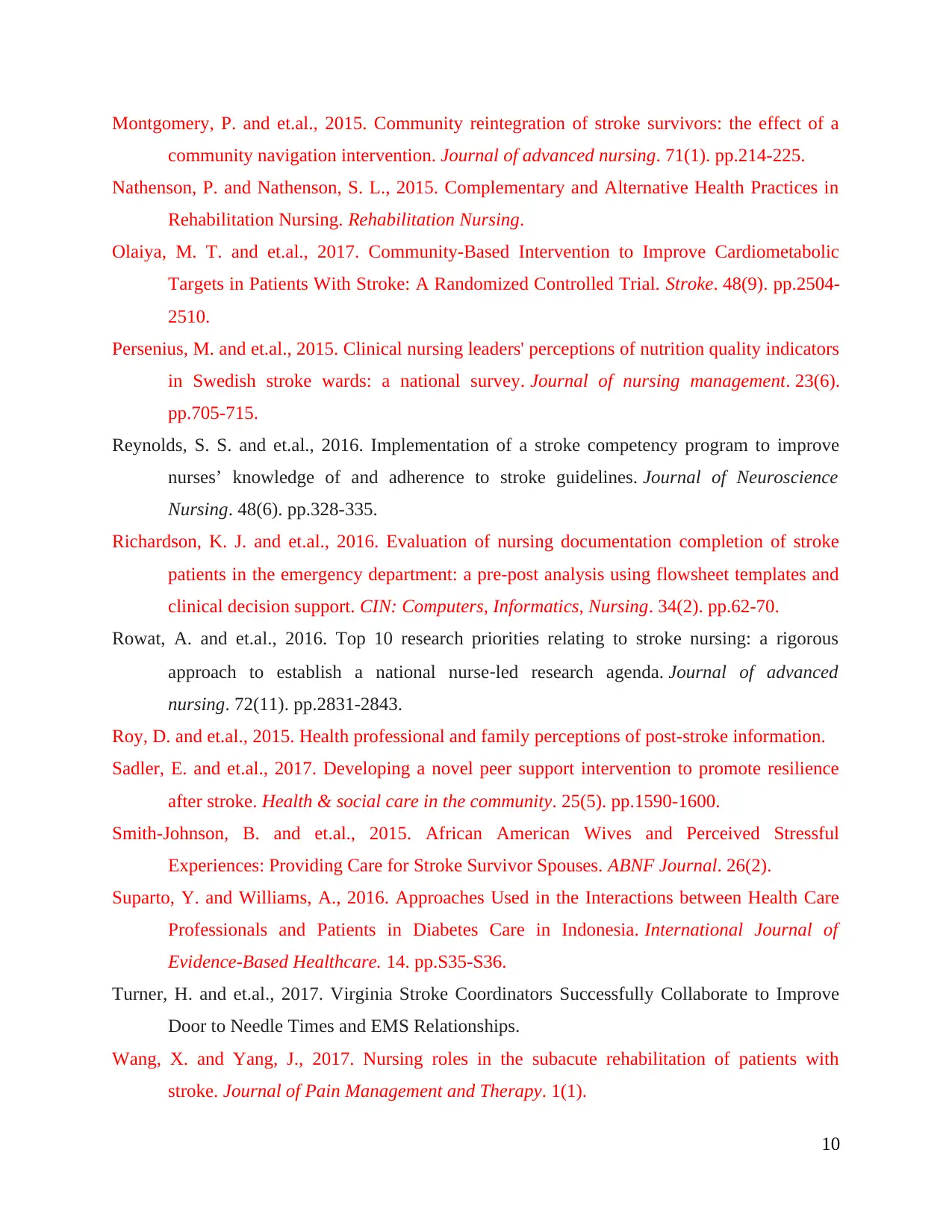
Montgomery, P. and et.al., 2015. Community reintegration of stroke survivors: the effect of a
community navigation intervention. Journal of advanced nursing. 71(1). pp.214-225.
Nathenson, P. and Nathenson, S. L., 2015. Complementary and Alternative Health Practices in
Rehabilitation Nursing. Rehabilitation Nursing.
Olaiya, M. T. and et.al., 2017. Community-Based Intervention to Improve Cardiometabolic
Targets in Patients With Stroke: A Randomized Controlled Trial. Stroke. 48(9). pp.2504-
2510.
Persenius, M. and et.al., 2015. Clinical nursing leaders' perceptions of nutrition quality indicators
in Swedish stroke wards: a national survey. Journal of nursing management. 23(6).
pp.705-715.
Reynolds, S. S. and et.al., 2016. Implementation of a stroke competency program to improve
nurses’ knowledge of and adherence to stroke guidelines. Journal of Neuroscience
Nursing. 48(6). pp.328-335.
Richardson, K. J. and et.al., 2016. Evaluation of nursing documentation completion of stroke
patients in the emergency department: a pre-post analysis using flowsheet templates and
clinical decision support. CIN: Computers, Informatics, Nursing. 34(2). pp.62-70.
Rowat, A. and et.al., 2016. Top 10 research priorities relating to stroke nursing: a rigorous
approach to establish a national nurse‐led research agenda. Journal of advanced
nursing. 72(11). pp.2831-2843.
Roy, D. and et.al., 2015. Health professional and family perceptions of post-stroke information.
Sadler, E. and et.al., 2017. Developing a novel peer support intervention to promote resilience
after stroke. Health & social care in the community. 25(5). pp.1590-1600.
Smith-Johnson, B. and et.al., 2015. African American Wives and Perceived Stressful
Experiences: Providing Care for Stroke Survivor Spouses. ABNF Journal. 26(2).
Suparto, Y. and Williams, A., 2016. Approaches Used in the Interactions between Health Care
Professionals and Patients in Diabetes Care in Indonesia. International Journal of
Evidence-Based Healthcare. 14. pp.S35-S36.
Turner, H. and et.al., 2017. Virginia Stroke Coordinators Successfully Collaborate to Improve
Door to Needle Times and EMS Relationships.
Wang, X. and Yang, J., 2017. Nursing roles in the subacute rehabilitation of patients with
stroke. Journal of Pain Management and Therapy. 1(1).
10
community navigation intervention. Journal of advanced nursing. 71(1). pp.214-225.
Nathenson, P. and Nathenson, S. L., 2015. Complementary and Alternative Health Practices in
Rehabilitation Nursing. Rehabilitation Nursing.
Olaiya, M. T. and et.al., 2017. Community-Based Intervention to Improve Cardiometabolic
Targets in Patients With Stroke: A Randomized Controlled Trial. Stroke. 48(9). pp.2504-
2510.
Persenius, M. and et.al., 2015. Clinical nursing leaders' perceptions of nutrition quality indicators
in Swedish stroke wards: a national survey. Journal of nursing management. 23(6).
pp.705-715.
Reynolds, S. S. and et.al., 2016. Implementation of a stroke competency program to improve
nurses’ knowledge of and adherence to stroke guidelines. Journal of Neuroscience
Nursing. 48(6). pp.328-335.
Richardson, K. J. and et.al., 2016. Evaluation of nursing documentation completion of stroke
patients in the emergency department: a pre-post analysis using flowsheet templates and
clinical decision support. CIN: Computers, Informatics, Nursing. 34(2). pp.62-70.
Rowat, A. and et.al., 2016. Top 10 research priorities relating to stroke nursing: a rigorous
approach to establish a national nurse‐led research agenda. Journal of advanced
nursing. 72(11). pp.2831-2843.
Roy, D. and et.al., 2015. Health professional and family perceptions of post-stroke information.
Sadler, E. and et.al., 2017. Developing a novel peer support intervention to promote resilience
after stroke. Health & social care in the community. 25(5). pp.1590-1600.
Smith-Johnson, B. and et.al., 2015. African American Wives and Perceived Stressful
Experiences: Providing Care for Stroke Survivor Spouses. ABNF Journal. 26(2).
Suparto, Y. and Williams, A., 2016. Approaches Used in the Interactions between Health Care
Professionals and Patients in Diabetes Care in Indonesia. International Journal of
Evidence-Based Healthcare. 14. pp.S35-S36.
Turner, H. and et.al., 2017. Virginia Stroke Coordinators Successfully Collaborate to Improve
Door to Needle Times and EMS Relationships.
Wang, X. and Yang, J., 2017. Nursing roles in the subacute rehabilitation of patients with
stroke. Journal of Pain Management and Therapy. 1(1).
10
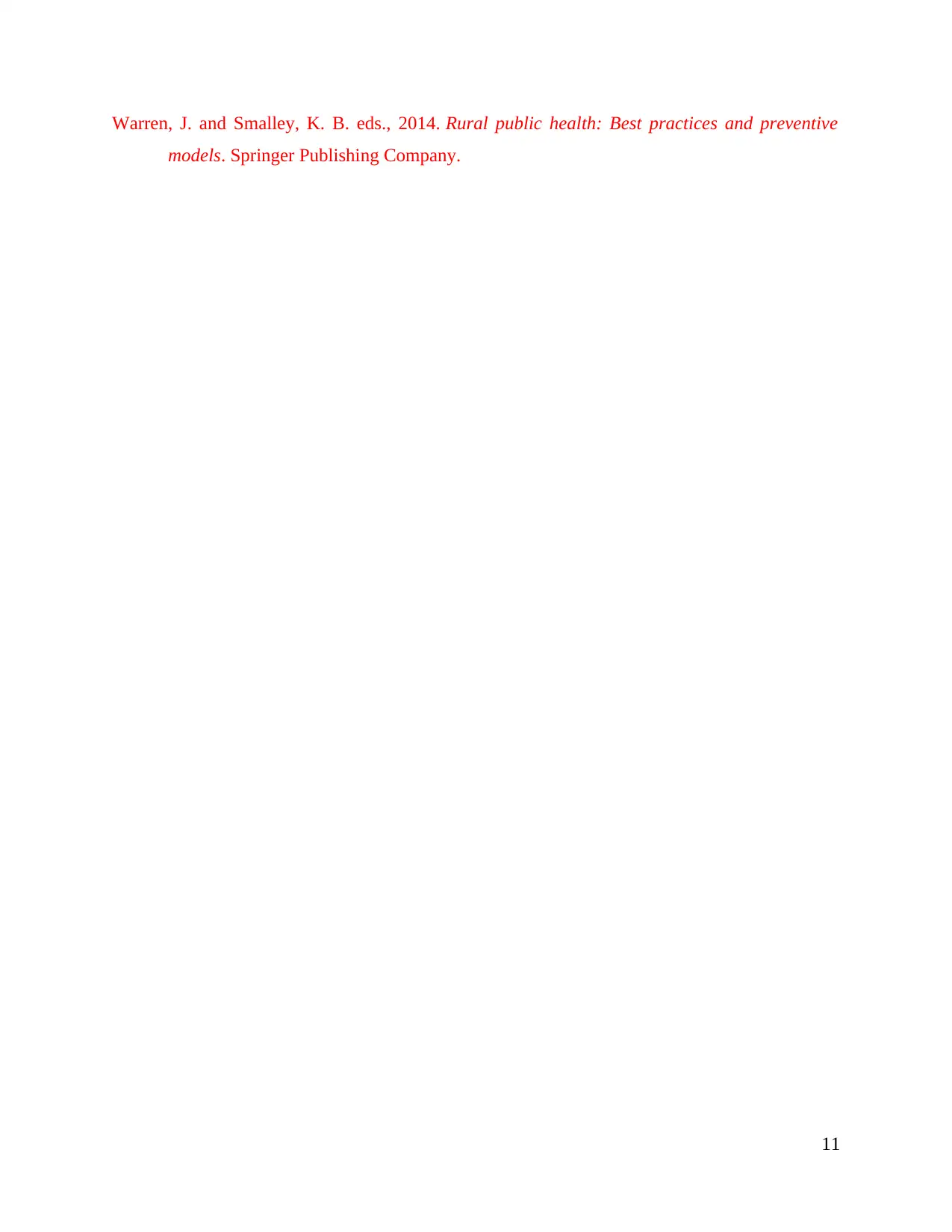
Warren, J. and Smalley, K. B. eds., 2014. Rural public health: Best practices and preventive
models. Springer Publishing Company.
11
models. Springer Publishing Company.
11
⊘ This is a preview!⊘
Do you want full access?
Subscribe today to unlock all pages.

Trusted by 1+ million students worldwide
1 out of 14
Related Documents
Your All-in-One AI-Powered Toolkit for Academic Success.
+13062052269
info@desklib.com
Available 24*7 on WhatsApp / Email
![[object Object]](/_next/static/media/star-bottom.7253800d.svg)
Unlock your academic potential
Copyright © 2020–2025 A2Z Services. All Rights Reserved. Developed and managed by ZUCOL.




